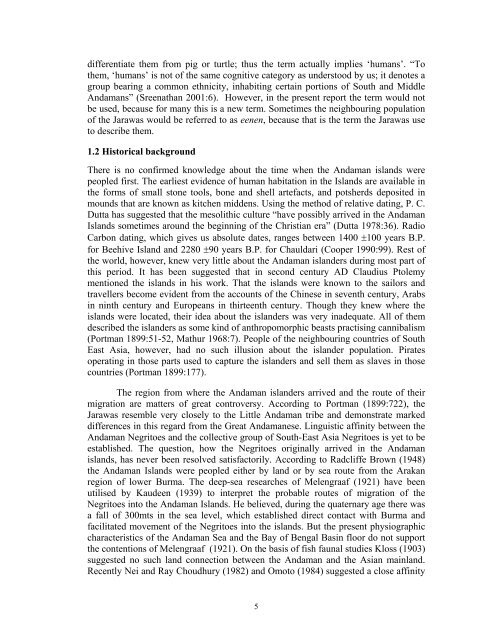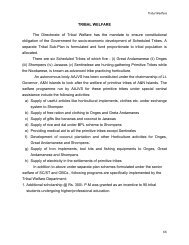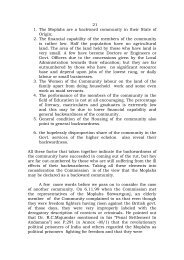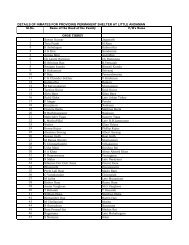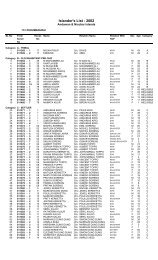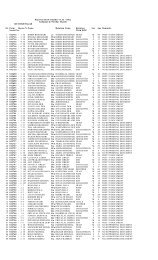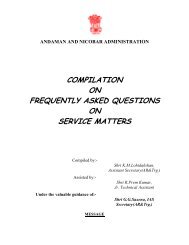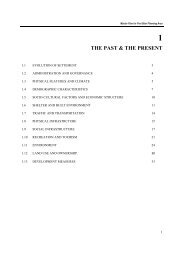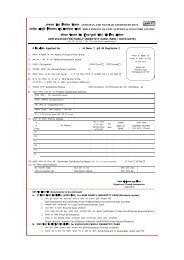1 Introduction - Andaman and Nicobar Islands
1 Introduction - Andaman and Nicobar Islands
1 Introduction - Andaman and Nicobar Islands
Create successful ePaper yourself
Turn your PDF publications into a flip-book with our unique Google optimized e-Paper software.
differentiate them from pig or turtle; thus the term actually implies ‘humans’. “To<br />
them, ‘humans’ is not of the same cognitive category as understood by us; it denotes a<br />
group bearing a common ethnicity, inhabiting certain portions of South <strong>and</strong> Middle<br />
<strong>Andaman</strong>s” (Sreenathan 2001:6). However, in the present report the term would not<br />
be used, because for many this is a new term. Sometimes the neighbouring population<br />
of the Jarawas would be referred to as eenen, because that is the term the Jarawas use<br />
to describe them.<br />
1.2 Historical background<br />
There is no confirmed knowledge about the time when the <strong>Andaman</strong> isl<strong>and</strong>s were<br />
peopled first. The earliest evidence of human habitation in the Isl<strong>and</strong>s are available in<br />
the forms of small stone tools, bone <strong>and</strong> shell artefacts, <strong>and</strong> potsherds deposited in<br />
mounds that are known as kitchen middens. Using the method of relative dating, P. C.<br />
Dutta has suggested that the mesolithic culture “have possibly arrived in the <strong>Andaman</strong><br />
Isl<strong>and</strong>s sometimes around the beginning of the Christian era” (Dutta 1978:36). Radio<br />
Carbon dating, which gives us absolute dates, ranges between 1400 ±100 years B.P.<br />
for Beehive Isl<strong>and</strong> <strong>and</strong> 2280 ±90 years B.P. for Chauldari (Cooper 1990:99). Rest of<br />
the world, however, knew very little about the <strong>Andaman</strong> isl<strong>and</strong>ers during most part of<br />
this period. It has been suggested that in second century AD Claudius Ptolemy<br />
mentioned the isl<strong>and</strong>s in his work. That the isl<strong>and</strong>s were known to the sailors <strong>and</strong><br />
travellers become evident from the accounts of the Chinese in seventh century, Arabs<br />
in ninth century <strong>and</strong> Europeans in thirteenth century. Though they knew where the<br />
isl<strong>and</strong>s were located, their idea about the isl<strong>and</strong>ers was very inadequate. All of them<br />
described the isl<strong>and</strong>ers as some kind of anthropomorphic beasts practising cannibalism<br />
(Portman 1899:51-52, Mathur 1968:7). People of the neighbouring countries of South<br />
East Asia, however, had no such illusion about the isl<strong>and</strong>er population. Pirates<br />
operating in those parts used to capture the isl<strong>and</strong>ers <strong>and</strong> sell them as slaves in those<br />
countries (Portman 1899:177).<br />
The region from where the <strong>Andaman</strong> isl<strong>and</strong>ers arrived <strong>and</strong> the route of their<br />
migration are matters of great controversy. According to Portman (1899:722), the<br />
Jarawas resemble very closely to the Little <strong>Andaman</strong> tribe <strong>and</strong> demonstrate marked<br />
differences in this regard from the Great <strong>Andaman</strong>ese. Linguistic affinity between the<br />
<strong>Andaman</strong> Negritoes <strong>and</strong> the collective group of South-East Asia Negritoes is yet to be<br />
established. The question, how the Negritoes originally arrived in the <strong>Andaman</strong><br />
isl<strong>and</strong>s, has never been resolved satisfactorily. According to Radcliffe Brown (1948)<br />
the <strong>Andaman</strong> Isl<strong>and</strong>s were peopled either by l<strong>and</strong> or by sea route from the Arakan<br />
region of lower Burma. The deep-sea researches of Melengraaf (1921) have been<br />
utilised by Kaudeen (1939) to interpret the probable routes of migration of the<br />
Negritoes into the <strong>Andaman</strong> Isl<strong>and</strong>s. He believed, during the quaternary age there was<br />
a fall of 300mts in the sea level, which established direct contact with Burma <strong>and</strong><br />
facilitated movement of the Negritoes into the isl<strong>and</strong>s. But the present physiographic<br />
characteristics of the <strong>Andaman</strong> Sea <strong>and</strong> the Bay of Bengal Basin floor do not support<br />
the contentions of Melengraaf (1921). On the basis of fish faunal studies Kloss (1903)<br />
suggested no such l<strong>and</strong> connection between the <strong>Andaman</strong> <strong>and</strong> the Asian mainl<strong>and</strong>.<br />
Recently Nei <strong>and</strong> Ray Choudhury (1982) <strong>and</strong> Omoto (1984) suggested a close affinity<br />
5


